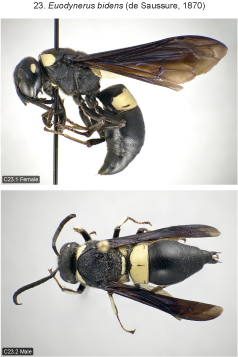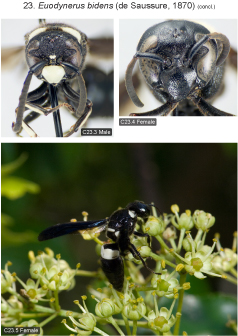
| Home | Table of contents | Keys | Species list | Glossary | Image data | PDF | Cite this article | Feedback | Updates |
Identification Atlas of the Vespidae (Hymenoptera, Aculeata) of the northeastern Nearctic region
CJAI 05, February 19, 2008
doi: 10.3752/cjai.2008.05
Matthias Buck, Stephen A. Marshall, and David K.B. Cheung
Department of Environmental Biology, University of Guelph, Guelph, Ontario, Canada N1G 2W1
Next species | Previous species | Key
23. Euodynerus bidens (de Saussure, 1870)
Figs B2.27, 45; B5.4, 5, 44; C23.1–5.

|

|
Species recognition. Euodynerus bidens is the only species of the genus which has the pale markings restricted to tergum 1 (small evanescent ivory spots sometimes occur on male tergum and sternum 2). The species thus more resembles Monobia quadridens than any other species of Euodynerus (differential diagnosis under that species). Other diagnostic characters besides those mentioned in the key include: female vertex very long, the distance between hind ocelli and occipital carina three times the distance between hind ocelli (at most two times in other species); cephalic foveae small and widely separated, area around them neither depressed nor with conspicuously different surface texture (in other species located in shallow depression bordered by posterior carina and area around them often more densely punctured than remainder of vertex); female pronotum, scutum and scutellum with unusually fine punctures; dorsal surface of propodeum largely ivory (black in other ivory-marked species except E. annectens); male fore trochanter and fore femur short-haired below (long-haired in other ivory-marked species, male of E. annectens not examined).
Variation. Fore wing length 11.5–13 mm (♂♂), 14–17 mm (♀♀). Interantennal spot present or absent in female. Apex of male clypeus sometimes with narrow black band. Scape black, sometimes brownish or with ivory spot near base in male. Mesopleuron black, sometimes with small ivory dorsal spot. Scutellum completely black or with a pair of small ivory spots. Male mid coxa usually with small ivory spot, sometimes largely ivory or completely black; male mid femur sometimes with ivory anteroapical spot. Tergum 1 largely ivory behind declivity, the ivory fascia anteromedially sometimes indented by a narrow longitudinal black stripe. Male tergum 2 sometimes with tiny discal or posterolateral ivory spots; male sternum 2 sometimes with small ivory posterolateral spots.
Distribution. Not recorded from Canada. Eastern U.S.: MN and NJ south to FL (Krombein 1979).
Biology. Unknown. The strongly compressed mid tarsus of the male indicates affinities with species in the E. foraminatus-group, all of which nest in borings in wood.
Next species | Previous species | Key
| Home | Table of contents | Keys | Species list | Glossary | Image data | PDF | Cite this article | Feedback | Updates |
